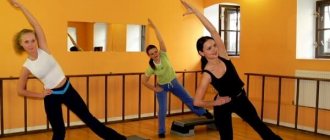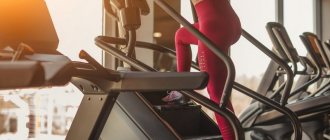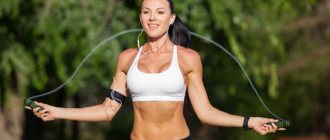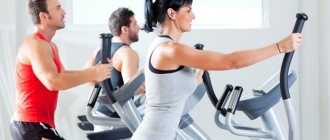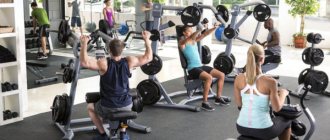As is usually the case, having decided to take a closer look at their health and start an active lifestyle, people are often faced with the problem of choice: today, fitness centers and sports complexes offer a huge number of different opportunities - from well-equipped gyms to large swimming pools.
Moreover, each type of physical activity (be it athletics, bodybuilding, or fitness) solves a specific problem, performs a specific task (fat burning, maintaining muscle tone, body shaping, etc.).
Aerobics is a set of gymnastic exercises performed to rhythmic music. And it is this type of exercise that is one of the most popular among people seeking to maintain a healthy lifestyle.
What is aerobics
Aerobic exercise is a great way not only to tone the body, but also to ensure the flow of oxygen to all organs and systems of the body.
Unlike fitness, where a certain strength load takes place, all aerobic exercises are quite simple and do not require special training, so even a person who has never played sports can easily endure a workout.
Aerobics classes include several basic elements:
- Working out all muscle groups of the body;
- Breathing exercises;
- Work on developing flexibility and plasticity.
The difference between aerobics and anaerobic exercise is the way energy is produced:
- During strength (anaerobic) training, glucose undergoes breakdown, resulting in the formation of a large number of lactic acid molecules, which are responsible for the growth of muscle mass, as well as ATP (adenosine triphosphoric acid) molecules, the main source of energy. A lot of lactic acid is released, but little ATP. As a result, there is an active process of muscle growth, while there is not enough energy for long-term strength activity (in bodybuilding, short periods of intense muscle work are practiced, followed by rest). During strength training, the body prefers to produce energy from carbohydrates.
- During aerobic exercise, the breakdown of glucose occurs with the participation of oxygen. Such training is characterized by a much lower intensity than strength training, so primarily fats are used as “fuel”. Saturating the body with oxygen allows you to exercise for 45-60 minutes without rest.
For greater clarity, we suggest studying the summary table:
| Aerobic exercise | Anaerobic exercise | |
| primary goal |
|
|
| Glucose breakdown | Occurs with the participation of oxygen. It takes a certain time to deliver oxygen to the cells (usually at least 20 minutes), so glycolysis proceeds more slowly, which requires increasing the duration of the session. | It occurs without the participation of oxygen, so lactic acid begins to be released almost immediately after the start of the workout, ensuring the rapid breakdown of carbohydrates. |
| Intensity | Medium – increase in heart rate to 60-80% of the maximum permissible norm (pulse on average 120-160 beats per minute) | High – increase in heart rate to a level of 80% or higher of the maximum permissible norm (pulse on average 170-190 beats per minute) |
| Duration of training | From 45 minutes and above (maximum – 1.5 hours). Active fat burning begins no earlier than 30 minutes after the start of the workout. | From 30 to 45 minutes. After this period, the body becomes exhausted (including oxygen starvation of the brain), which prolongs the recovery process and makes training ineffective. |
| Energy release | ATP molecules are formed in large quantities, which provides endurance and allows you to actively engage in 45-60 minutes. | Few ATP molecules are formed, so you can’t exercise for more than 45 minutes. |
It is worth noting that currently most sports programs are “hybrid” - athletes actively combine aerobic and anaerobic exercise to achieve the most effective results. For example, in aerobics, after 10-15 minutes of cardio exercise, a small 5-minute strength set follows - an exercise with large weights (dumbbells, barbells, training on machines).
The benefit of aerobics is that, in addition to burning fat, during exercise there is increased ventilation of the lungs and, as a result, activation of the heart.
The essence of aerobics at home
Aerobics at home is a significant physical activity that helps you lose weight and strengthen muscle tissue. The essence of the classes comes down to performing cyclically repeated exercises to rhythmic music. The body has a complex effect, the functioning of all organs and systems is corrected, including the respiratory, nervous and brain.
What are the benefits of aerobics?
Like any type of physical activity, aerobics brings great benefits to our body
:
- Heart training
. The heart muscle, like other muscles, needs constant support, especially since the health of our body largely depends on it. It’s not for nothing that aerobics is called a cardio exercise - during exercise, not only the muscles of the musculoskeletal system are actively trained, but also the heart (as a result, blood circulation improves, and the organs receive the maximum amount of nutrients). - Lung training
. During aerobic exercise, the volume of “consumed” air increases significantly. This is achieved through the right combination of motor and breathing exercises. As a result, all organs and systems of the body receive a sufficient amount of oxygen necessary for proper metabolism. - Training all muscle groups
. During aerobic exercise, almost all muscles work, which ensures they are constantly maintained in sufficient tone. A tangible advantage of aerobics is that due to the active enrichment of cells with oxygen, there is practically no increase in muscle mass (lactic acid is not produced), therefore, it is impossible to “pump up” while doing aerobics. - Stimulation of the gastrointestinal tract
. The activity of the abdominal muscles well stimulates the functioning of the stomach and intestines, which will ensure the absence of intestinal disorders, constipation, flatulence, etc.
In addition, there are a huge number of benefits of aerobics specifically for losing weight and figure:
- Active burning of subcutaneous fat
. During active cardio training, it is fat cells, not carbohydrates, that are used as an energy source, while a slight increase in muscle mass occurs.
Don’t be afraid if after 2-3 weeks of aerobics (provided you follow your diet), the number on the scales has not decreased at all, or maybe even on the contrary – it has become higher. The fact is that fat cells have less mass than muscle cells, so with a significant decrease in body volume (due to fat burning), weight can remain at the same level.
- Improving body contour
. The absence of excess weight is not always the main condition for a beautiful figure. Thin people who neglect physical activity experience sagging muscles and skin, which does not add beauty to their figure. Regular aerobic training will help you easily maintain normal weight and also provide your muscles with good tone and relief.
Among other things, aerobic exercise provides a comprehensive health effect:
- Improving endurance indicators.
- Improved posture.
- Prevention of cardiovascular diseases.
- Training of the vestibular apparatus (development of a sense of balance, coordination of movements).
- Reducing blood pressure by activating the work of the heart muscle, increasing the size and number of capillaries.
- Normalization of metabolism in the body.
- Improving the psychological state, preventing stress, resting after serious mental activity, normalizing sleep, etc.
An important advantage of aerobic training is its low intensity, making this type of physical activity suitable for everyone, regardless of age, gender, body type and physical fitness. At the same time, it is women who most often attend classes:
- Aerobics is a fairly easy way to get rid of a couple of extra pounds and make your figure attractive and graceful.
- This is an excellent option for preventing breast cancer, as well as good rehabilitation assistance for people who have undergone surgery to remove a tumor.
- Cardio training is an excellent opportunity to absolutely safely strengthen the pelvic muscles, which will be very useful during pregnancy and childbirth, and will also help to avoid congestion in the pelvic organs.
The benefits of aerobics for the body as a whole are very significant - it is not for nothing that this type of activity (along with swimming) is recommended for people who have undergone surgery and need to restore vitality.
Examples of aerobic exercise for weight loss
Depending on your initial level of training, you should choose a specific set of aerobic exercises for weight loss.
Simple workout
The main movements are springy jumps and arm swings. These are the simplest exercises, but if you do them every day for 30-40 minutes, then after 30 days the muscles will noticeably strengthen and the skin will tighten.
First level
An excellent option for those who have just started doing aerobics, but can already easily perform a simple workout. The lesson begins with a warm-up, then there is learning the movements and the final part (the main one) is a repetition of the learned exercises at a fast pace with a certain rhythm.
Average level
You should move on to it only after mastering the basic exercises for beginners, because the intermediate level is a combination of movements. For example, there will be leg swings while squatting. It’s not difficult, but beginners will need to hold their breath, not lose their rhythm and tempo - they learn this, they get used to it with simple training and at the initial level.
Intense fat burning
The essence of training is alternating exercise cycles. First, a warm-up is performed, then there is 15 minutes of intense work (fast pace, active movements, maximum load). You can perform 2-3 such cycles in the minutes allotted for the entire workout. Fat burning will proceed rapidly, the first results can be observed not only on the scale, but also in appearance after 2-3 weeks.
Complex training
The most difficult type of aerobics, it is performed only after the previous stages have been completed, and the weight has already decreased by 10-15 kg from the initial indicators. Comprehensive training includes:
- waist exercises with hula hoop;
- abdominal training;
- exercises to correct the hips and buttocks;
- strengthening the back muscles.
Watch this video on how to lose weight quickly by doing an intense aerobics workout:
Indications for aerobic training
Aerobics is not just one of the popular sports. Aerobic training is often recommended by doctors as therapeutic exercise for people in need of recovery from injuries and illnesses. Medical indications for aerobics include the following:
- Restoration of the body after long-term illnesses, especially if bed rest has been observed for a long time.
- Rehabilitation after injuries, fractures or operations. During this period, it is important to ensure minimal load.
- Lack of regular physical activity, sedentary work.
- Constant feeling of fatigue, sleep disturbance, stress, tendency to depression, irritability.
- Overweight and obesity (training intensity is determined based on the severity of the problem).
- Prevention of certain diseases (diabetes mellitus, heart attacks and strokes).
Aerobic exercise is an excellent way to strengthen the immune system, so it is recommended for people who are often sick and have difficulty withstanding infectious viral diseases.
Contraindications to aerobic exercise
Despite the fact that aerobics brings a lot of benefits and has a general health-improving effect, before starting exercises, it is necessary to obtain a comprehensive consultation with a doctor. However, there are a number of contraindications to attending training:
- Early period of rehabilitation after serious operations and injuries (surgical interventions, fractures, sprains, etc.). It is recommended to begin active restoration of motor activity no earlier than after 1.5-2 months.
- Diseases of the cardiovascular system (heart failure, tachycardia), blood diseases.
- Chronic diseases in the acute stage.
- Infectious viral diseases.
- Diseases of the musculoskeletal system, osteochondrosis.
- Phlebeurysm.
If you neglect the recommendations of doctors, then aerobics will do more harm than good. In addition, do not forget about control over the intensity of your training: do not try to surpass yourself - in no case should you work “to exhaustion”.
For effective weight loss, a fitness program should contain:
- Psychological mood.
- Proper nutrition.
- Regular classes.
- Water procedures.
Such alternative methods to improve your figure and health will help bring your body back to normal, increase mental activity and forget about shortness of breath, fatigue and other problems.
Psychological mood.
There is no need to be afraid of your fears; lack of confidence in your abilities is quite understandable. Every undertaking initially inspires fear, so there is nothing wrong with that. The main thing is to accept the psychological aspect of playing sports. There is a lot to learn about fitness for weight loss, working out and nutrition. However, do not be afraid of difficulties. It all depends on desire and faith in one’s strength.
Advice: Take note, every morning tell yourself: “I believe in my strength, I will succeed, I love myself very much and accept myself for who I am.” Make a plan for executing the program that is most convenient for you.
Proper nutrition.
The diet should include only healthy foods: fruits, vegetables, juices.
Water. If you drink little fluid, it will be much more difficult to lose weight. Because with water deficiency, all metabolic processes in the body slow down. Therefore, it is recommended to drink 5-8 glasses of water per day.
Vitamins. Buy a complex of vitamins at the pharmacy and take it every day of training. Since vitamins play the most important role in the entire human body, promoting rapid fat burning.
Protein food. Protein is required to form muscle mass. And the more muscle mass you have, the more fat you burn—even if you're just resting. The best sources of protein are chicken breast, egg whites, fish and turkey.
Regular classes.
Fitness training for weight loss must be regular, otherwise the desired effect will not be achieved. Choose different directions and types of physical activity to your liking, so that the activities bring pleasure.
SK "Manege" will provide you with a huge range of fitness services for weight loss. Starting from the gym to group programs.
Working out in the gym will help you tone your figure, strengthen your muscles and become slim. The means for such exercises can be very different: dumbbells, a tourniquet, weights, barbells, and so on.
And if you want the lesson to be not only useful and effective, but also fun and energizing, welcome to the fitness room for group programs.
Group classes are an integral part of modern fitness for weight loss. And no wonder. After all, group classes accompanied by music are very emotional. This emotional attitude helps you train with greater dedication. Thanks to the wide variety of lessons, group classes do not get boring. Here everyone can find exactly what they like. These include strength lessons, mixed format lessons, Pilates and yoga...
Water procedures.
If possible, go swimming, to the steam room or to the sauna, and harden yourself. Weight loss during bath procedures occurs due to improved metabolic processes in the body and the removal of salts and toxins. After 1 visit you can reduce your weight by 2 kg. To enhance the effect, rub your body with salt or honey before the procedure.
Conclusion: Fitness for weight loss is a whole series of activities. Only comprehensive implementation of which will help you permanently get rid of extra pounds and acquire a slim and beautiful figure.
Aerobics during pregnancy
During pregnancy, all your plans regarding physical activity should be discussed with your doctor. In some cases (threat of miscarriage or premature birth, placenta previa, etc.), even despite the woman’s excellent health, the doctor may categorically prohibit any exercise. But in most cases, moderate activity is not only possible, but highly recommended for many reasons:
- Saturation of all organs and tissues with oxygen is beneficial not only for the expectant mother, but also for the baby.
- Heart training will maximize the body's endurance, which will be very useful during labor.
- Training the abdominal and pelvic muscles, which will also help during childbirth.
- Improving emotional state, normalizing sleep, which is especially important during the period of bearing a child.
- Prevention of edema and varicose veins.
- Eliminates the possibility of gaining extra pounds.
During pregnancy, it is important not to overdo it with training - excessive exercise can lead to an increase in the tone of the uterus, which, in turn, can provoke spontaneous miscarriage (in the early stages) or premature birth (in the third trimester). In addition, this can lead to fetal hypoxia - oxygen starvation.
It is also recommended to exclude jumping, running, and any sudden movements (especially active movements of the pelvis) from the aerobic training program.
Do not forget that pregnancy is the time when a woman must first of all take care of her health and the health of her unborn baby. Therefore, if previously the workouts were very intense and lasted more than an hour, now it is advisable to slow down the pace and reduce the training time to 45 minutes.
The best option is to find a good group for pregnant women, where all aerobic exercises will be designed specifically for expectant mothers.
Aerobics at home for weight loss with Ekaterina Firsova
Ekaterina Firsova is a certified trainer who has developed an aerobics complex for losing weight at home. The specialist focuses on strength exercises, which not only help burn fat, but also perfectly strengthen muscles, making the whole body slim and toned.
The advantage of classes with Ekaterina Firsova:
- Its arsenal includes programs for beginners and people more experienced in sports.
- She spends a lot of time stretching and claims that you can do the splits at any age and with any weight.
- Even those who have restrictions on sports due to the health of the spine and joints can practice her lessons (but consultation with a doctor will be required).
Main types of aerobics
Aerobics is a relatively young type of physical activity, and today there are several separate areas, each of which has its own distinctive features:
- Classic aerobics
. Rhythmic dance moves to fast music that sets the rhythm and allows you to keep the tempo well. All muscle groups are strengthened, oxygen exchange is enhanced, the heart is strengthened, posture improves, the body becomes toned, flexible and flexible. - Water aerobics
. In this case, aerobic exercises are carried out in water. All muscle groups, joints and ligaments are worked out, and thanks to a light massage with water, the skin is tightened, the “orange peel” effect is removed, and the appearance of cellulite is reduced. Water aerobics has a minimum of contraindications; even people with heart disease and varicose veins are allowed to practice. - Step aerobics
. All exercises are performed using a special platform - steppe. During training, the muscles of the abs, thighs and buttocks actively work, the relief of the body is well developed, and the cardiovascular and respiratory systems are strengthened. - Dance
. Its main difference from the classical one is that the movements here are more complex, dance-like, and the music can be very different. All muscles are strengthened and tightened, posture improves. Dance aerobics gives a huge boost of positive energy, so it helps fight stress and all its manifestations (sleep disturbances, irritability, chronic fatigue). - Aerobics with fitball
. Here all exercises are performed with a large ball - a fitball. The main feature of this direction is the ability to work deep muscle groups. In addition, posture is restored, general well-being and mood improve. - Strength aerobics
. The name speaks for itself - during training, not only energetic aerobic movements to music are used, but also anaerobic (strength) exercises. During training, dumbbells, barbells, and exercise machines are used. The result is an excellent cardio workout, exercise for the heart and respiratory system, a slender, toned body, and elastic muscles.
In addition, all types of aerobics in the case of regular active training help fight excess weight and excess fat deposits.
ADVANTAGES AND DISADVANTAGES OF STEP AEROBICS
Step aerobics has a number of benefits that have made it one of the most popular group classes. But step exercises also have a number of disadvantages and contraindications, so they are not suitable for everyone.
ADVANTAGES AND BENEFITS OF STEP AEROBICS
- Step aerobics is one of the most effective types of cardio exercise for losing weight and getting rid of excess fat. In 1 hour of exercise you can burn 300-500 kcal.
- Step aerobics classes are much safer for joints than, for example, running, plyometrics, and jumping rope. With comparable results and energy costs, you will get a relatively low impact on the leg joints.
- This is an excellent workout for the lower body, which is the most problematic for the fair sex. You will tone the muscles of your thighs and buttocks, tightening and improving their shape. Moreover, steps on the steppe help dry out the legs and reduce their size.
- Step aerobics classes are suitable for the prevention of osteoporosis and arthritis, which is especially important for those who lead a sedentary lifestyle.
- When you do step aerobics, you force your heart and lungs to work more efficiently and make them healthier. Such training reduces the likelihood of cardiovascular diseases several times.
- Regular step aerobics classes will help you maintain a healthy weight, avoiding problems associated with excess body weight: diabetes, stroke, metabolic disorders, joint pain, heart problems.
- Step aerobics will help you develop endurance, which will be useful not only during training, but also in everyday life. For example, when climbing stairs to a high floor, during long walks, or climbing uphill. Step aerobics also develops coordination, agility and a sense of balance.
- You can independently adjust the difficulty of the workout by changing the height of the step platform. The higher the platform level, the stronger the load you will receive.
- Step aerobics consists of weight-bearing exercises that are ideal for increasing bone density and maintaining bone tissue. This will not only make you more mobile, but will also help prevent bone disease in adulthood.
- You can do step aerobics not only in special classes, but also at home. There are also free video lessons for beginners, thanks to which you can learn the basics of aerobics on the steppe.
DISADVANTAGES OF STEP AEROBICS
- Stepping exercises are less impactful on your joints than running and jumping, but if you are worried about your knee joints, then this type of fitness can aggravate this problem. If the problem with the joints is acute, then it is better to pay attention to Pilates classes.
- Step aerobics is very diverse and has practically no single template. Each instructor brings his own characteristics to the teaching of lessons, so not all classes are equally effective and of high quality.
- Exercises on the step involve the muscles of the legs and buttocks, while the muscles of the upper body will not receive enough load. In addition, step aerobics must be supplemented with strength training to comprehensively improve your body.
- Step aerobics puts stress on the Achilles tendon, which is located just above the heel of the foot. If proper technique is not followed, platform steps can cause injury or rupture of the Achilles.
- Step aerobics uses combinations of steps and sequences that can take time to learn. During the first lessons, students often get confused in their steps and do not keep up with the trainer, which discourages them from doing step aerobics.
CONTRAINDICATIONS FOR STEP AEROBICS:
- Diseases of the cardiovascular system
- Diseases of the joints of the legs
- Diseases of the musculoskeletal system
- High blood pressure
- Phlebeurysm
- Large excess weight
- Pregnancy and postpartum period (3 months)
- A long break from fitness activities (it is better to start with regular walking of 5-7 km per day)
If you have other medical conditions that may prevent you from exercising, it is best to further consult with your doctor.
EFFECTIVENESS OF STEP AEROBICS FOR WEIGHT LOSS
Is step aerobics effective for losing weight? Before answering this question, let's remember the basic principle of losing excess weight. Your body begins to lose weight when you consume fewer calories than your body can burn. Regardless of training, if you eat less than your daily calorie intake (creating a calorie deficit), your body begins to use fat from its reserve reserves for energy.
Cardio exercise is a great way to burn calories, which is why step aerobics is effective for weight loss. In one hour-long session you can burn one full meal, which means it will bring you closer to your desired goal faster. In addition, step aerobics tones muscles, affects subcutaneous fat by increasing blood circulation, gives energy and relieves stress (which will help avoid overeating).
Of course, there are more energy-intensive workouts that will help you burn more calories in an hour of exercise than during step aerobics. But you need to understand that they will probably be more impactful and traumatic than step classes. In addition, step aerobics specifically reduces volume and dries out the lower body, rather than making it heavier.
STEP AEROBICS FOR BEGINNERS: 10 FEATURES
1. Be sure to remember the correct body position while performing step aerobics exercises: knees slightly bent, back straight, stomach tucked in, buttocks tense, shoulders straight, gaze directed forward.
2. Steps must be taken with the entire foot on the platform so that the heel does not hang down.
3. In step aerobics there are no steps in two counts - at least four. This is due to the fact that you not only need to move along the floor, but also climb onto the platform.
4. In step aerobics, unlike classical aerobics, there are no reverse steps.
5. At first, in step aerobics classes, it will probably be difficult for you to repeat the exercises after the instructor. You may even get lost and confused in your steps. This is absolutely normal, after 3-4 lessons you will feel much more confident.
6. The higher the step platform is located, the more intense the load. Beginners should choose a height of 10-15 cm. More experienced practitioners should choose 20 cm. Gradually, the height of the projectile can be increased. It has been established that every plus 5 cm added to the height of the step platform will provide an additional 12% of the load.
7. You can make your step workout more challenging by using dumbbells or weights on your legs or arms.
8. Half an hour before your workout, drink a glass of water and be sure to take a few sips of water every 10 minutes during your workout.
9. If your gym offers step aerobics of several difficulty levels, then it is better to choose a class for beginners, even if you have good physical fitness from other workouts.
10. Remember the movements first with your “legs” and only then with your “hands”. Engage your arms only when the lower body has fully mastered the movements.
BASIC STEP AEROBICS EXERCISES
To make it easier for you to master step aerobics, we offer you several basic step aerobics exercises in visual pictures.
1. Basic Step
Step onto the step platform with both feet alternately. Performed in four counts.
2. V-steps or V-steps
Step one step at a time with both feet on opposite corners of the step.
3. Step with shin overlapping or Curl
Step your right foot onto the corner of the step platform and swing your left foot back. The heel should touch the left buttock. Then do it on the other side.
4. Step with knee lift or Knee up
Step your right foot onto the corner of the step platform, bend your left knee and pull it towards your stomach. Then do it on the other side.
5. Step with leg lift or Kick up
Step your right foot onto the corner of the step platform and throw your left foot forward. Then do it on the other side.
6. Touching the floor
Standing in the middle of the step platform, alternately touch the floor with one foot and then the other.
7. Pull your leg back
Step your right foot onto the corner of the step platform, and take your left foot as far back as possible, without bending it at the knee. Raise your arms in sync with your legs. Then do it on the other side.
8. Leg abduction
Step your right foot onto the step platform and take your left foot to the side without bending it at the knee. Move your arms to the side synchronously with raising your legs. Then do it on the other side.
General recommendations for aerobics
Initially, it may seem that there is nothing difficult in doing aerobics. In fact, even such simple training requires a special approach:
- Any workout should always begin with a warm-up, and aerobics is no exception. Warm-up exercises will help warm up your muscles and protect you from sprains.
- To achieve a noticeable effect from aerobic exercise, it is important to attend them regularly - 2-3 times a week, and for weight loss, 4-5 workouts are allowed.
- Aerobic training should last from 45 to 90 minutes, depending on your level of fitness - beginners are unlikely to be able to withstand 1.5 hours of active cardio classes.
- It is recommended to start with a small load, gradually increasing it. To do this, you need to monitor your heart rate. During aerobic exercise, it is allowed to increase heart rate to 60-85% of the maximum.
Calculating your target heart rate (heart rate recommended during cardio training) is quite simple:
220 – age = maximum heart rate
Maximum heart rate – resting heart rate = reserve heart rate
Resting heart rate + (60-85%) of heart rate reserve = target heart rate
For example, a 30-year-old person’s heart rate at rest is 70; during cardio training, it is planned to increase the heart rate to 80% of the maximum:
220 – 30 = 190 (maximum heart rate)
190 – 70 = 120 (heart rate reserve)
70 + 120 * 80 / 100 = 166 (target heart rate)
Remember: self-torture is unlikely to bring you much benefit. Exhaustion of the body, a long recovery period - this is what those who do not know the limits risk earning.
- Aerobic exercise alone is unlikely to get you in shape. To achieve the desired effect, an integrated approach is needed:
- proper nutrition (increase the amount of protein in the diet, replace fast carbohydrates with slow ones, reduce the amount of fat consumed, eliminate fast food). Eat at least 3 times a day, plus 2 snacks between main meals. No starvation!
- giving up bad habits (remember: cardio training and smoking are incompatible!);
- active lifestyle;
- healthy sleep at least 8 hours a day.
It is also important not to forget to drink as much clean, non-carbonated water as possible: it helps cleanse the body of accumulated toxins and protects against dehydration.
Don’t forget about comfortable clothes and shoes for exercise: loose shorts and a T-shirt, sports leggings and a T-shirt top (today you can find things on sale with a stimulating effect), gymnastics tights, sneakers or sports slippers are perfect.
Aerobics at home
Since this sport includes an abundance of different types, you can easily find one that is suitable for home - without additional equipment and increased stress.
For home workouts, you can purchase dumbbells (they will make training to strengthen muscles more effective), expanders (work both with the muscles of the arms, legs, buttocks), push-ups (to make push-ups more convenient and effective), a gymnastic mat (for more comfortable exercises on the floor). This minimum will suit you for basic training at home. You can also work the muscles of the abs, arms, buttocks and back.
Of course, you won’t be able to do intense cardio training at home, since you need space for it, and you can only do step training if you have a large room. However, you can combine strength exercises with small dance elements.
The main condition for home training is consistency.
Regularity and correctness of exercises will give you visible results. Don't forget to watch your diet, which also affects your physical fitness and your mood. Catalog
What is more effective: aerobics at home or in a fitness club?
If you have definitely decided that aerobics is exactly what you need, the next question arises: where to practice - at home or in a fitness club? It is difficult to give a definite answer to this question - after all, we are all different, and our habits and preferences are very different. However, both training at home and training in a club have their advantages and disadvantages:
Fitness club classes
- an experienced instructor who will always help, advise, and support;
- a cheerful atmosphere, a lot of people who literally “share” their energy with you;
- “group enthusiasm”, a desire for healthy competition, a desire to “show oneself” - all this will help achieve the desired result;
- classes take place at a specific time;
- All necessary equipment is available - mats, step pads, fitballs, exercise machines, etc.
- the coach focuses on the “achievement” of the majority, and most often these are people with an average level of training (if you are a beginner, it will be quite difficult for you to catch up with more experienced colleagues).
Exercises at home
- a video with a recording of the training acts as an instructor;
- training time - at any time convenient for you;
- a home environment has a more positive effect on many people than the noisy atmosphere of a fitness club;
- home workouts are an ideal option for reserved, shy people;
- you can choose any music you like, practice while listening to your favorite video;
- the necessary equipment for classes will have to be purchased or rented;
- It is often difficult to perform certain exercises and movements correctly.
Thus, it is best to get your first experience of aerobic training in a fitness club under the careful supervision of an experienced instructor. Once you understand the basic movements, you can move on to home workouts.
But in general, you can successfully combine both options - work out 2 times a week in the fitness room, and 2 times a week at home.
At the same time, home workouts can be supplemented or replaced with running, jumping rope, cycling - after all, all this is also considered elements of aerobics!
Aerobic exercise and its effect on the body
Perhaps anyone who was interested in the life of ballerinas knows that professional ballerinas train for 10-12 hours a day, and this is not just training, but quite heavy physical activity in an aerobic mode, while they have a very strict diet, since their weight ballerinas should not exceed 50 kg.
Aerobic exercise, like any aerobic exercise for weight loss , requires a certain expenditure of calories, so in an hour of aerobic training with average intensity, about 300 kcal are burned. Knowing this, you can easily calculate how much a ballerina spends during her 10-hour working day: 10x300 = 3000 kcal.
So, on average, a ballerina spends only 3000 kcal on physical exercise, and in addition to this, there is also a basic metabolism, which on average spends about 1000 kcal, as well as such things as: sleeping, cleaning, cooking, traveling on public transport or walking down the street, meeting friends, perhaps even an active nightlife (maybe an energizer ballerina). In general, she spends at least another 1000 kcal per day on all this. In total, it turns out that our miniature ballerina spends about 5000 kcal per day!!!!! Can you imagine that this is not a small number. Only professional bodybuilders and miners spend more, and we are talking about a small and fragile ballerina.
So here the question immediately arises: why, with such a COLOSSAL calorie consumption, are ballerinas also limited in food??? After all, in fact, they can eat like elephants and not gain weight! But instead, they constantly keep themselves under a tight rein, and they are not allowed to rest more than once a week, because by stopping rehearsals and daily training, the ballerinas relax, begin to eat more than usual, because they feel the long-awaited freedom and lack of constant control and reproaches about their weight, and therefore very quickly lose shape and begin to gain weight by leaps and bounds.
Aerobics for weight loss is famous for this: by doing it regularly (unless, of course, you are a ballerina), you can treat yourself to your favorite cakes from time to time and immediately burn calories during long workouts, but only you will quit classes, and the habit of not denying yourself anything will be the same and stays with you, you will instantly notice how you begin to store all the unspent calories on your hips, buttocks and waist. An example is the same former ballerinas who quit sports and stopped dancing, as well as dance and aerobics coaches who quit coaching and training themselves. After some time, they begin to gain excess weight, and some even “blur” to very large sizes. I won’t say anything about all the former ballerinas and coaches, but those who don’t watch their diet and continue to “trample” buns and chocolate bars from memory, forgetting that now these extra calories are not so easy to burn without constant training, here They are the ones who change beyond recognition. An example is the well-known superstar, ballerina Anastasia Volochkova, who is now very difficult to recognize and believe that she once flew around the stage like a feather.
But the time has come to analyze the mechanism of aerobic exercise, and why does aerobics for weight loss help you lose excess weight NOW, and in the FUTURE it can become the other side of the coin and be the reason for gaining this same excess weight and several times more?
